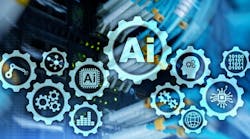Looking to implement AI-powered remote operations? This is what you must know
Enterprises large and small are rushing to reduce barriers their workforces must overcome to consume data and become more “data literate.” In this dynamic data landscape, modern manufacturing looks towards the convergence of artificial intelligence (AI) and remote operations technology to accelerate digital transformation.
A typical industrial facility can have from 100,000 to millions of data points continuously updating across more than 50 applications, some faster than once per second. Unstructured data types are also increasing with more reliance on images, videos, acoustic, 3D models, point clouds, and engineering drawings to provide additional context on the state of operations.
See also: Revolutionizing manufacturing: The role of industrial AI
An AI-powered remote operations control room (ROCR) is a popular and worthwhile pursuit for manufacturers seeking to harness the transformative power of AI in their pursuit of operational excellence. An ROCR consolidates digital solutions to provide a centralized view of all your industrial data, enabling cross-data source insights to understand and solve real-time safety, reliability, and quality risks across the operation.
Take Celanese’s ROCR, which is the backbone of their Digital Plant of the Future. Their ROCR consists of eight product status screens and dashboards, including Flawless Day KPIs, live production data, reported incidents, a video livestream, energy consumption cost, a 3D model view of the site, maintenance information, and Copilot, a product of my company, Cognite.
By integrating AI-driven analytics and a deterministic generative AI copilot in a ROCR solution, operational leaders can access and explore data through natural-language prompts or even voice commands, enhancing decision-making capabilities.
Critical to an ROCR: A contextualized data foundation
Contextualization of data means to uncover and identify relationships between elements of data that are connected but where the relationships are not explicitly represented. Take Google Maps, for example, which effortlessly combines map data with information from the web (rating, direction, hours of operation, nearby activities, busiest times, and so on) to provide users with a unified interface to quickly answer multiple questions from a single, seamless experience. The value of data contextualization is the automated discovery of real-time information.
Survey: Almost all manufacturers struggle with making use of data
Contextualization can be done in many ways depending on the type of data and the kind of relationship—some of the techniques are simple pattern matching, and others can rely on having a lot of domain knowledge, but it is the continual contextualization of disparate data sources that creates a rich data foundation for operational innovation. This is one way AI comes into play.
Achieving contextualized data at scale within a single site and, more broadly, across an enterprise requires establishing many contextualization pipelines through AI-powered contextualization services that use pre-trained machine learning-based models, custom ML-based models, a rules engine, and manual/expert-sourced mappings.
See also: Navigating Industry 4.0: A guide for the rest of us
By using AI-powered contextualization to build a strong data foundation, manufacturers shift the emphasis from data storage and cataloging to a true human data discovery experience. Generative AI can then be used to simplify this data discovery experience even more.
However, for gen-AI to work in industry, it needs context. Large language models (LLMs) such as ChatGPT are trained on tens of billions to hundreds of billions of parameters, yet data sets of this size don’t exist for industrial environments. Using generic LLMs on uncontextualized, unstructured industrial data significantly increases the risk of hallucinations. Manufacturers must have a contextualized data foundation to enable generative AI solutions to provide the right answers in industrial environments.
See also: Industrial OT widely vulnerable to intrusion, survey finds
By starting with the data foundation and unlocking generative AI-enhanced data exploration, manufacturers can identify and build high-impact use cases that align with strategic objectives and deliver tangible value incrementally. Then, they can scale these digital solutions into a comprehensive AI-powered ROCR solution, unlocking new opportunities for operational excellence, innovation, and growth.
As we stand on the cusp of a new era in manufacturing, embracing AI-powered remote operations is not merely a choice but a strategic imperative for organizations looking to thrive in an increasingly competitive and dynamic marketplace.




